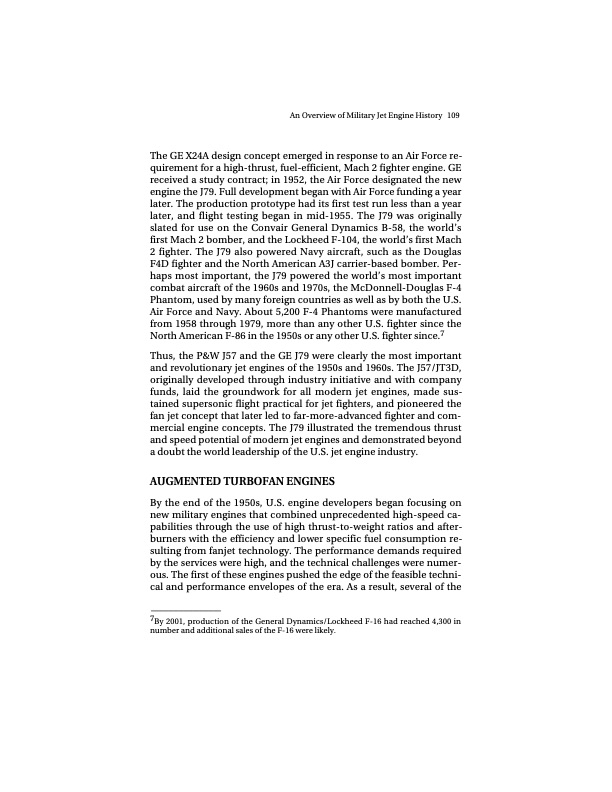
PDF Publication Title:
Text from PDF Page: 124
An Overview of Military Jet Engine History 109 The GE X24A design concept emerged in response to an Air Force re- quirement for a high-thrust, fuel-efficient, Mach 2 fighter engine. GE received a study contract; in 1952, the Air Force designated the new engine the J79. Full development began with Air Force funding a year later. The production prototype had its first test run less than a year later, and flight testing began in mid-1955. The J79 was originally slated for use on the Convair General Dynamics B-58, the world’s first Mach 2 bomber, and the Lockheed F-104, the world’s first Mach 2 fighter. The J79 also powered Navy aircraft, such as the Douglas F4D fighter and the North American A3J carrier-based bomber. Per- haps most important, the J79 powered the world’s most important combat aircraft of the 1960s and 1970s, the McDonnell-Douglas F-4 Phantom, used by many foreign countries as well as by both the U.S. Air Force and Navy. About 5,200 F-4 Phantoms were manufactured from 1958 through 1979, more than any other U.S. fighter since the North American F-86 in the 1950s or any other U.S. fighter since.7 Thus, the P&W J57 and the GE J79 were clearly the most important and revolutionary jet engines of the 1950s and 1960s. The J57/JT3D, originally developed through industry initiative and with company funds, laid the groundwork for all modern jet engines, made sus- tained supersonic flight practical for jet fighters, and pioneered the fan jet concept that later led to far-more-advanced fighter and com- mercial engine concepts. The J79 illustrated the tremendous thrust and speed potential of modern jet engines and demonstrated beyond a doubt the world leadership of the U.S. jet engine industry. AUGMENTED TURBOFAN ENGINES By the end of the 1950s, U.S. engine developers began focusing on new military engines that combined unprecedented high-speed ca- pabilities through the use of high thrust-to-weight ratios and after- burners with the efficiency and lower specific fuel consumption re- sulting from fanjet technology. The performance demands required by the services were high, and the technical challenges were numer- ous. The first of these engines pushed the edge of the feasible techni- cal and performance envelopes of the era. As a result, several of the ______________ 7By 2001, production of the General Dynamics/Lockheed F-16 had reached 4,300 in number and additional sales of the F-16 were likely.PDF Image | Military Jet Engine Acquisition Technology Basics and Cost-Estimating Methodology

PDF Search Title:
Military Jet Engine Acquisition Technology Basics and Cost-Estimating MethodologyOriginal File Name Searched:
MR1596.pdfDIY PDF Search: Google It | Yahoo | Bing
NFT (Non Fungible Token): Buy our tech, design, development or system NFT and become part of our tech NFT network... More Info
IT XR Project Redstone NFT Available for Sale: NFT for high tech turbine design with one part 3D printed counter-rotating energy turbine. Be part of the future with this NFT. Can be bought and sold but only one design NFT exists. Royalties go to the developer (Infinity) to keep enhancing design and applications... More Info
Infinity Turbine IT XR Project Redstone Design: NFT for sale... NFT for high tech turbine design with one part 3D printed counter-rotating energy turbine. Includes all rights to this turbine design, including license for Fluid Handling Block I and II for the turbine assembly and housing. The NFT includes the blueprints (cad/cam), revenue streams, and all future development of the IT XR Project Redstone... More Info
Infinity Turbine ROT Radial Outflow Turbine 24 Design and Worldwide Rights: NFT for sale... NFT for the ROT 24 energy turbine. Be part of the future with this NFT. This design can be bought and sold but only one design NFT exists. You may manufacture the unit, or get the revenues from its sale from Infinity Turbine. Royalties go to the developer (Infinity) to keep enhancing design and applications... More Info
Infinity Supercritical CO2 10 Liter Extractor Design and Worldwide Rights: The Infinity Supercritical 10L CO2 extractor is for botanical oil extraction, which is rich in terpenes and can produce shelf ready full spectrum oil. With over 5 years of development, this industry leader mature extractor machine has been sold since 2015 and is part of many profitable businesses. The process can also be used for electrowinning, e-waste recycling, and lithium battery recycling, gold mining electronic wastes, precious metals. CO2 can also be used in a reverse fuel cell with nafion to make a gas-to-liquids fuel, such as methanol, ethanol and butanol or ethylene. Supercritical CO2 has also been used for treating nafion to make it more effective catalyst. This NFT is for the purchase of worldwide rights which includes the design. More Info
NFT (Non Fungible Token): Buy our tech, design, development or system NFT and become part of our tech NFT network... More Info
Infinity Turbine Products: Special for this month, any plans are $10,000 for complete Cad/Cam blueprints. License is for one build. Try before you buy a production license. May pay by Bitcoin or other Crypto. Products Page... More Info
| CONTACT TEL: 608-238-6001 Email: greg@infinityturbine.com | RSS | AMP |